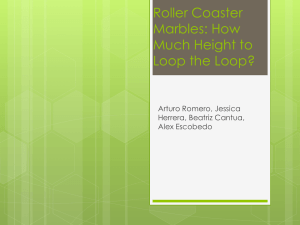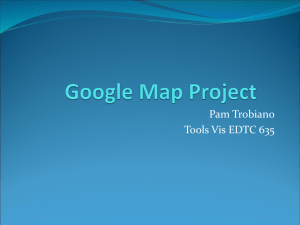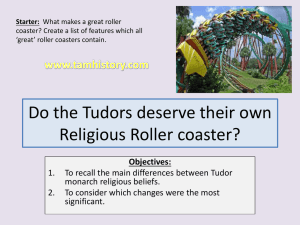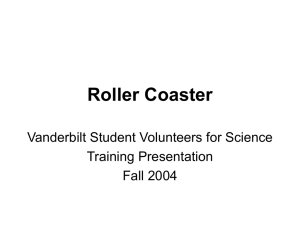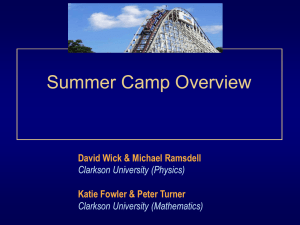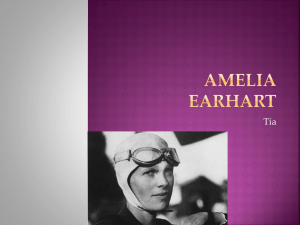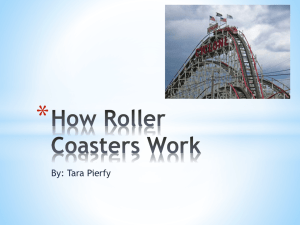Physics Conservation of Energy Project ROLLER COASTER
advertisement
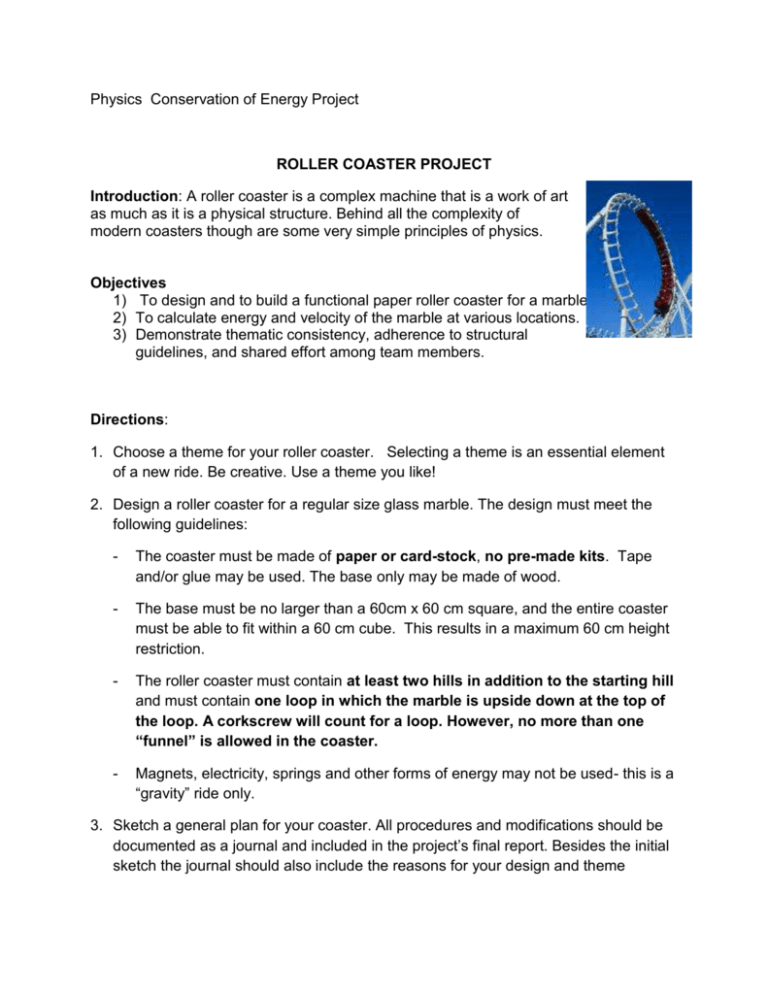
Physics Conservation of Energy Project ROLLER COASTER PROJECT Introduction: A roller coaster is a complex machine that is a work of art as much as it is a physical structure. Behind all the complexity of modern coasters though are some very simple principles of physics. Objectives 1) To design and to build a functional paper roller coaster for a marble. 2) To calculate energy and velocity of the marble at various locations. 3) Demonstrate thematic consistency, adherence to structural guidelines, and shared effort among team members. Directions: 1. Choose a theme for your roller coaster. Selecting a theme is an essential element of a new ride. Be creative. Use a theme you like! 2. Design a roller coaster for a regular size glass marble. The design must meet the following guidelines: - The coaster must be made of paper or card-stock, no pre-made kits. Tape and/or glue may be used. The base only may be made of wood. - The base must be no larger than a 60cm x 60 cm square, and the entire coaster must be able to fit within a 60 cm cube. This results in a maximum 60 cm height restriction. - The roller coaster must contain at least two hills in addition to the starting hill and must contain one loop in which the marble is upside down at the top of the loop. A corkscrew will count for a loop. However, no more than one “funnel” is allowed in the coaster. - Magnets, electricity, springs and other forms of energy may not be used- this is a “gravity” ride only. 3. Sketch a general plan for your coaster. All procedures and modifications should be documented as a journal and included in the project’s final report. Besides the initial sketch the journal should also include the reasons for your design and theme choices, the description of the modifications and progress of the project, difficulties and problems encountered and the solutions you found to go around them. 4. Construct your actual roller coaster model. You are likely to achieve the best results by testing and combining different types of paper and similar materials that are flexible enough to allow you to build the loops and hills in your design. Make the coaster simple, but with “visual appeal”. 5. Each model will have three runs. The longest time from the start position to the finish line will be the official time for that model. On graph paper (or on computer) make a draw-to-scale diagram of your roller coaster and label with letters the following points: beginning of coaster, bottom of loop, top of loop, top of any hill and bottom of hill. 6. For the calculations: find the mass of the marble and assume there is no dissipated energy. For each lettered point on the diagram of your roller coaster, calculate the following values: gravitational potential energy, kinetic energy and speed of coaster. Calculate carefully and accurately. Show all of your calculations in an organized manner and include units. Show all your data in a table that summarizes your calculated results: point, height, GPE, KE, Total energy, speed. 7. Physics Analysis: The project’s report should contain an explanation about the physics laws governing roller coaster design, a comprehensive description how roller coasters work and how different variables affect roller coaster design. For example, what happens to the coaster when we change variables such as the height of hills, length of track, mass of the coaster, and speed of the coaster? Why don’t the cars of a roller coaster fly off the track? Why don’t passengers fly out of the cars? How high can the first hill of a roller coaster be? What physics laws determine how many hills, curves, and loops a roller coaster track can have? What is the role of gravity and friction? As an introduction of the project’s report, discuss a little about the history of roller coasters, advantages and disadvantages in wooden and steel roller coasters, most famous ones and any other interesting facts about roller coasters. In Summary: Final project will include: Roller coaster 50% Built to specifications, marble completes runs in contact with track, thematic consistency, artistic impact, solid design and run consistency Report 50% physics analysis of roller coaster design, history of roller coasters, diagram and calculations, project log Assessment: 1. Roller Coaster Model (50%) Correct materials, neat construction and assembly Correct dimensions, free standing Two hills (besides starting hill) and one loop Marble is in contact with track Interesting, original, realistic ride, unexpected thrills and consistent theme. 2. Report (50%) Introduction: concise, informative, history and types and advantages of different models included Physics analysis: comprehensive description of all aspects of the laws of physics behind coaters design and the effect of all the variables involved well explained. Diagram: neat, properly labeled and to scale Calculations: comprehensive, neat, accurate, and easy-to-follow. Data table included. Journal: complete procedural process documented including who and when work was carried out. Due Dates:
